Pore Structure Differences and Influencing Factors of Tight Reservoirs Under Gravity Flow–Delta Sedimentary System in Linnan Subsag, Bohai Bay Basin
Abstract
1. Introduction
2. Geological Settings
3. Samples and Experimental Methods
3.1. Sample and Data
3.2. Pore Structure Characterization Experiments
3.3. Fractal Dimension Feature Analysis
4. Results
4.1. Petrological Characteristics
4.2. Physical Property Characteristics
4.3. Pore Systems
4.3.1. Qualitative Analysis
4.3.2. Quantitative Analysis
4.4. Pore Size Distribution
4.5. Fractal Dimension Features
- (1)
- Two-segment fractal characteristics: These characteristics correspond to the Type A and B pore–throat combinations in turbidite sandstones (Figure 9b,c) and the Type D and F types in delta front sandstones (Figure 9f,h). As shown in Table 1, in turbidite reservoirs, the fractal dimension D1 for relatively coarse pores ranges from 2.995 to 2.998, with an average value of 2.997. The fractal dimension D2 for relatively fine pores ranges from 2.643 to 2.702, with an average value of 2.674. In the delta front sandstone reservoirs, the fractal dimension D1 for relatively coarse pores ranges from 2.997 to 2.998, with an average value of 2.998. The fractal dimension D2 for relatively fine pores ranges from 2.730 to 2.808, with an average value of 2.771. In delta front sandstone reservoirs, the average values of fractal dimensions D1 and D2 of the Type D and Type F pore–throat combinations are both higher than those of Type A and B in turbidite sandstones, indicating a more complex pore size distribution and pronounced heterogeneity in delta front sandstones. The delta front reservoirs exhibit the highest D1 value, reflecting as markedly heterogeneous for the macroscopic pore–fracture network. The average value of D2 of turbidite sandstones is low. Under the combined influence of compaction, cementation, and dissolution during the diagenesis processes, the pore–throat distribution of the reservoirs is uniform and the homogeneity is pronounced.
- (2)
- Three-segment fractal characteristics: These correspond to the Type C pore–throat combination in turbidite sandstones (Figure 9d) and Type E in delta front sandstone reservoirs (Figure 9g). As shown in Table 1, in turbidite reservoirs, the fractal dimension D1 for relatively coarse pores is 2.997, D2 is 2.927, and D3 for relatively fine pores is 2.644. In delta front reservoirs, the fractal dimension D1 for relatively coarse pores ranges from 2.992 to 2.995, with an average of 2.993. D2 ranges from 2.726 to 2.810, with an average of 2.762. D3 ranges from 2.078 to 2.283, with an average of 2.206. The average values of the fractal dimensions D1 and D2 segments of the Type C pore–throat combination in turbidite sandstones are both higher than those of Type E in delta fronts. The D1 segment implies that the pore size distribution within the turbidite reservoirs is more complex and heterogeneous. Moreover, complex and multi-branched flow channels have been formed under the influence of sedimentation. The D2 segment is predominantly controlled by diagenesis. Under the combined modification of compaction, cementation, and dissolution, the turbidite reservoirs exhibit enhanced heterogeneity and an increased complexity of fluid-flow pathways. The D3 segment fractal dimension characterizing micropores in the turbidite sandstones is significantly larger than that of the delta front reservoirs, indicating that the micropore diameters in turbidite sandstones exceed those in delta fronts. The Type E pore–throat combination developed in delta front facies exhibits a relatively uniform micropore distribution and pronounced homogeneity, while the small micropore diameters limit the fluid-flow capacity.
5. Discussion
5.1. The Impact of Sedimentation on Reservoir Pore Structure in Two Sedimentary Systems
5.1.1. The Impact of Sedimentary Facies on Pore Structure
5.1.2. Impact of Lithofacies on Pore Structure
5.2. The Impact of Diagenesis and Diagenetic Facies on Reservoir Pore Structure in Two Sedimentary Systems
5.2.1. Impact of Diagenesis on Pore Structure
- (1)
- Compaction
- (2)
- Cementation
- (3)
- Carbonate cementation
- (4)
- Clay cementation
- (5)
- Siliconeous cementation
- (6)
- Dissolution
5.2.2. The Impact of Diagenetic Facies on Pore Structure
- (1)
- Medium compaction–medium cementation–strong dissolution diagenetic facies (according to the Type A pore structure): The diagenetic facies developed in the fine sandstone lithofacies, with moderate grain compaction primarily characterized by point contacts and residual primary pores were relatively well preserved. In addition, both carbonate and clay cementation are moderate. Influenced by the proximity to source rocks rich in organic acids, the dissolution process is pronounced, resulting in noticeable intergranular carbonate cement dissolution pores and intragranular debris dissolution pores, ultimately forming a coarse pore–coarse throat pore structure with an average surface pore rate of 6.68% (Figure 13a1,a2).
- (2)
- Medium compaction–medium cementation–weak dissolution diagenetic facies (according to the Type B pore structure): The diagenetic facies as a whole exhibit moderate compaction, predominantly characterized by point and point-line contacts. While some primary pores are well preserved, the cementation is moderate, with a degree of cementation like that of the previous diagenetic facies. These diagenetic facies have developed mainly in the siltstone lithofacies of turbidite reservoirs. Influenced by the mineral composition of the rocks, the debris content is relatively low and the dissolution process is weak, ultimately forming a medium-porosity pore structure with an average surface pore rate of 4.41% (Figure 13b1,b2).
- (3)
- Medium compaction–strong cementation–weak dissolution diagenetic facies (according to the Type C pore structure): This type of diagenetic facies developed in the reservoirs of argillaceous siltstone lithofacies and exhibited moderate compaction but strong cementation. Compared with that in delta front reservoirs, the overall cementation in turbidite sedimentary reservoirs is relatively weak. However, the high clay content in the argillaceous siltstone lithofacies led to strong clay cementation. Additionally, influenced by the lithofacies, the high clay content and low abundance of easily dissolvable minerals result in weak dissolution. Owing to the comprehensive effects of various diageneses, the reservoirs in these diagenetic facies feature partially filled intergranular carbonate cements and clay-filled materials, with clay minerals primarily consisting of illite and illite/smectite mixed layers. Therefore, the average surface pore rate is 2.12%, with a fine pore–medium throat pore structure (Figure 13c1,c2).
- (4)
- Medium compaction–strong cementation–strong dissolution diagenetic facies (according to the Type D pore structure): The diagenetic facies developed in the fine-siltstone lithofacies are located at the high structural position of the delta front facies. Although these diagenetic facies experience stronger compaction than the three types in turbidite reservoirs, they remain the least compacted within the delta front facies because of their relatively shallow burial depth, with an overall moderate degree of compaction. Delta front reservoirs generally exhibit high cementation contents and strong cementation characteristics, with fewer residual primary pores. Additionally, the intergranular filling consists of carbonate cements and clay infill. The high feldspar content in the fine-siltstone lithofacies is subject to the stronger dissolution of feldspar than that of debris and carbonate cements. In other words, strong dissolution leads to both well-developed intergranular and intragranular dissolution pores, ultimately resulting in a medium pore–coarse throat pore structure with an average surface pore rate of 1.99% (Figure 13d1,d2).
- (5)
- Strong compaction–strong cementation–medium dissolution diagenetic facies (according to the Type E pore structure): These facies develop in the calcareous siltstone lithofacies and are controlled by the delta sedimentary system in the study area, corresponding to a medium pore–fine throat pore structure with an average surface pore rate of 1.68%. This diagenetic facies exhibit significant compaction, with quartz grains showing pressure dissolution and sutured contacts. Moreover, the calcareous siltstone lithofacies show strong carbonate cementation. Under the combined effects of strong compaction and cementation, a small number of primary pores are preserved. The degree of dissolution is moderate, with the observable dissolution of feldspar and intergranular carbonate cements, resulting in complex and variable pore–throat types. Occasional occurrences of feldspar transforming into kaolinite are noted, and this kaolinitization process can also generate a small number of secondary pores (Figure 13e1,e2).
- (6)
- Strong compaction–strong cementation–weak dissolution diagenetic facies (according to the Type F pore structure): The diagenetic facies developed in the argillaceous layered siltstone lithofacies in the central and western parts of the study area are characterized by a relatively low quartz content and weak compaction resistance but a high degree of compaction. The high mud content is accompanied by significant cementation, which preserves only a small number of intergranular residual primary pores. In addition, the intergranular spaces are generally filled with carbonate cements. There are few easily dissolvable minerals, leading to weak dissolution effects. Therefore, fine pore diameters and strong heterogeneity can be found within reservoirs. These diagenetic facies correspond to a fine pore–fine throat pore structure with an average surface pore rate of only 0.86%. However, notably, intercrystalline micropores account for a large proportion of the total pore area, which consists of micropores within kaolinite minerals (Figure 13f1,f2).
5.3. Genetic Mechanisms of Reservoir Pore Structures in Different Sedimentary Systems
5.4. Implication for Tight Oil Recovery
6. Conclusions
- (1)
- Quantitative pore structure analysis identifies six types: In turbidite sandstones, pores and throats range from coarse-coarse (Type A) through medium-medium (Type B) to fine-medium (Type C). In delta front sandstones, they progress from medium-coarse (Type D) via medium-fine (Type E) to fine-fine (Type F). The integration of HPMI, NMR, and SEM data reveals that turbidite reservoirs exhibit comparatively enhanced pore structure characteristics relative to those of delta front tight sandstones.
- (2)
- Sedimentation furnishes the material basis for reservoir space development. Two depositional settings are classified into six reservoir lithofacies—three turbidite (Type A: fine sandstone; Type B: siltstone; Type C: argillaceous siltstone) and three delta front (Type D: fine-siltstone; Type E: calcareous siltstone; Type F: argillaceous layered siltstone)—each directly linked to a specific pore structure type. This lithofacies–pore correlation clarifies how contrasting sedimentary processes govern the structure and connectivity of reservoir pore systems.
- (3)
- Diagenesis governs reservoir pore structures: compaction and cementation diminish the porosity, whereas dissolution augments it. Accordingly, six diagenetic facies—medium compaction–medium cementation–strong dissolution; medium compaction–medium cementation–weak dissolution; medium compaction–strong cementation–weak dissolution; medium compaction–strong cementation–strong dissolution; strong compaction–strong cementation–medium dissolution; and strong compaction–strong cementation–weak dissolution—are defined, each mapping to pore structure Types A–F, respectively.
- (4)
- The reservoir pore structures in the study area result from the interplay of sedimentary and diagenetic controls, with six combined lithofacies and diagenetic facies defining distinct pore structure types. An optimal coarse pore–coarse throat pore structure (Type A) develops in turbidite fine sandstone lithofacies under medium compaction–medium cementation–strong dissolution diagenetic facies. Conversely, the poorest fine-pore–fine-throat pore structure (Type F) occurs in delta front argillaceous layered siltstone lithofacies subjected to strong compaction, strong cementation, and weak dissolution. Furthermore, turbidite reservoirs generally exhibit higher oil contents than delta front counterparts, and the oil content systematically declines as the pore structures transition from Type A to Type F.
Author Contributions
Funding
Institutional Review Board Statement
Informed Consent Statement
Data Availability Statement
Acknowledgments
Conflicts of Interest
References
- Wang, X.G.; Huan, J.L.; Peng, X.J.; Zhang, C.; Yuan, W. Flow mechanism and pore structures of tight sandstone based on digital core analysis. Pet. Geol. Recovery Effic. 2022, 29, 22–30. [Google Scholar] [CrossRef]
- Cheng, J.; Ge, H.; Yang, W.; Zuo, B.; Li, Q.; Liang, X. Development and testing of surfactants for high-temperature and high-salt reservoirs. Unconv. Oil Gas 2023, 10, 57–62. [Google Scholar] [CrossRef]
- Zhu, H.J.; Ju, Y.W.; Huang, C. Microcosmic gas adsorption mechanism on clay-organic nanocomposites in a marine shale. Energy 2020, 197, 117256. [Google Scholar] [CrossRef]
- Huang, F.F.; Pu, C.S.; Gu, X.Y. Study of a low-damage efficient-imbibition fracturing fluid without flowback used for low-pressure tight reservoirs. Energy 2021, 222, 119941. [Google Scholar] [CrossRef]
- Liu, H.M.; Gao, Y.; Qin, F.; Yang, H.Y. New fields, new types and resource potentials of hydrocarbon exploration in Jiyang depression, Bohai Bay Basin. Acta Pet. Sin. 2023, 44, 2141–2159. [Google Scholar] [CrossRef]
- Wu, P.; Hu, S.; Shen, Z.; Fu, B.; Liang, X.; Zhang, Y. Study on fine characterization and application of composite sand body in meander zone of Z Oilfield. Unconv. Oil Gas 2023, 10, 18–25. [Google Scholar] [CrossRef]
- Zhang, J.Y.; Tao, S.Z.; Wu, S.T.; Liu, G.D.; Zhao, W.Z.; Li, G.H. Controlling effect of pore-throat structures on tight oil accumulation effectiveness in the upper Cretaceous Qingshankou formation, Songliao Basin. Geoenergy Sci. Eng. 2023, 225, 211689. [Google Scholar] [CrossRef]
- Wang, Y.S.; Chen, T.; Zhang, P.F.; Zhai, Z. Exploration potential and direction of Palaeogene light crude oil reservoirs in Jiyang depression. Acta Pet. Sin. 2021, 42, 1605–1614. [Google Scholar] [CrossRef]
- Liu, B.; Mohammadi, M.; Ma, Z.; Bai, L.; Wang, L.; Xu, Y.; Ostadhassan, M.; Hemmati-Sarapardeh, A. Evolution of porosity in kerogen type I during hydrous and anhydrous pyrolysis: Experimental study, mechanistic understanding, and model development. Fuel 2023, 338, 127–149. [Google Scholar] [CrossRef]
- Clarkson, C.R.; Wood, J.M.; Burgis, S.E.; Aquino, S.D.; Freeman, M. Nanopore-structure Analysis and Permeability Predictions for a Tight Gas Siltstone Reservoir by Use of Low-Pressure Adsorption and Mercury-Intrusion Techniques. SPE Res. Eval. Eng. 2012, 15, 648–661. [Google Scholar] [CrossRef]
- Zou, C.N.; Yang, Z.; Tao, S.; Yuan, X.J.; Zhu, R.K.; Hou, L.H.; Wu, S.T.; Sun, L.; Zhang, G.S.; Bai, B.; et al. Continuous hydrocarbon accumulation over a large area as a distinguishing characteristic of unconventional petroleum: The Ordos Basin, North-Central China. Earth Sci. Rev. 2013, 126, 358–369. [Google Scholar] [CrossRef]
- Loucks, R.G.; Ruppel, S.C.; Wang, X.; Ko, L.; Peng, S.; Zhang, T.; Rowe, H.D.; Smith, P. Pore types, pore-network analysis, and pore quantification of the lacustrine shale-hydrocarbon system in the Late Triassic Yanchang Formation in the southeastern Ordos Basin, China. Interpretation 2017, 5, SF63–SF79. [Google Scholar] [CrossRef]
- Soeder, D.J. Reservoir properties and pore structure of tight gas sands. AAPG Bull. 1984, 68, 530–531. [Google Scholar] [CrossRef]
- Zeng, J.H.; Yang, Z.F.; Feng, X.; Qiao, J.C.; Zhang, Z.Y. Study status and key scientific issue of tight reservoir oil and gas accumulation mechanism. Adv. Earth Sci. 2014, 29, 651–661. [Google Scholar] [CrossRef]
- Lai, J.; Wang, G.W. Fractal analysis of tight gas sandstones using high-pressure mercury intrusion techniques. J. Nat. Gas Sci. Eng. 2015, 24, 185–196. [Google Scholar] [CrossRef]
- Schmitt, M.; Fernandes, C.P.; Wolf, F.G.; da Cunha Neto, J.A.B.; Rahner, C.P.; dos Santos, V.S.S. Characterization of Brazilian tight gas sandstones relating permeability and angstrom-to micron-scale pore structures. J. Nat. Gas Sci. Eng. 2015, 27, 785–807. [Google Scholar] [CrossRef]
- Clarkson, C.R.; Freeman, M.; He, L.; Agamalian, M.; Melnichenko, Y.B.; Mastalerz, M.; Bustin, R.M.; Radliński, A.P.; Blach, T.P. Characterization of tight gas reservoir pore structure using USANS/SANS and gas adsorption analysis. Fuel 2012, 95, 371–385. [Google Scholar] [CrossRef]
- Clarkson, C.R.; Solano, N.; Bustin, R.M.; Bustin, A.M.M.; Chalmers, G.R.L.; He, L.; Melnichenko, Y.B.; Radliński, A.P.; Blach, T.P. Pore structure characterization of North American shale gas reservoirs using USANS/SANS, gas adsorption, and mercury intrusion. Fuel 2013, 103, 606–616. [Google Scholar] [CrossRef]
- Wu, S.T.; Zhu, R.K.; Yang, Z.; Mao, Z.G.; Cui, J.W.; Zhang, X.X. Distribution and characteristics of lacustrine tight oil reservoirs in China. J. Asian Earth Sci. 2019, 178, 20–36. [Google Scholar] [CrossRef]
- Wu, S.T.; Lin, S.Y.; Chao, D.J.; Zhai, X.F.; Wang, X.R.; Huang, X.; Xu, J.L. Fluid mobility evaluation based on pore structure investigation in tight sandstones: Case study of Upper Triassic Chang 6 tight sandstone in Huaqing area, Ordos Basin. Nat. Gas Geosci. 2019, 30, 1222–1232. [Google Scholar] [CrossRef]
- Song, Y.; Luo, Q.; Jiang, Z.X.; Yang, W.; Liu, D.D. The enrichment of tight oil and its controlling factors in central and western China. Petrol. Explor. Dev. 2021, 48, 1–13. [Google Scholar] [CrossRef]
- Sun, P.K.; Xu, H.M.; Zhu, H.Q.; Jia, L.B.; Hu, X.N.; Fang, H.J.; Jiang, H.Q.; Xu, Z.H.; Jiang, T.W.; Jiang, X.; et al. Investigation of pore-type heterogeneity and its control on microscopic remaining oil distribution in deeply buried marine clastic reservoirs. Mar. Petrol. Geol. 2021, 123, 104750. [Google Scholar] [CrossRef]
- Qin, Y.; Yao, S.P.; Xiao, H.M.; Cao, J.; Hu, W.X.; Sun, L.H.; Tao, K.Y.; Liu, X.W. Pore structure and connectivity of tight sandstone reservoirs in petroleum basins: A review and application of new methodologies to the Late Triassic Ordos Basin, China. Mar. Pet. Geol. 2021, 129, 105084. [Google Scholar] [CrossRef]
- Nelson, P.H. Pore-throat sizes in sandstones, tight sandstones, and shales. AAPG Bull. 2009, 93, 329–340. [Google Scholar] [CrossRef]
- Loucks, R.G.; Reed, R.M.; Ruppel, S.C.; Hammes, U. Spectrum of pore types and networks in mudrocks and a descriptive classification for matrix-related mudrock pores. AAPG Bull. 2012, 96, 1071–1098. [Google Scholar] [CrossRef]
- Shanley, K.W.; Cluff, R.M. The evolution of pore-scale fluid-saturation in low-permeability sandstone reservoirs. AAPG Bull. 2015, 99, 1957–1990. [Google Scholar] [CrossRef]
- Xi, K.L.; Cao, Y.C.; Haile, B.G.; Zhu, R.K.; Jahren, J.; Bjørlykke, K.; Zhang, X.X.; Hellevang, H. How does the pore-throat size control the reservoir quality and oiliness of tight sandstones? the case of the Lower Cretaceous Quantou Formation in the southern Songliao Basin, China. Mar. Pet. Geol. 2016, 76, 1–15. [Google Scholar] [CrossRef]
- Wimmers, K.; Koehrer, B. Integration of sedimentology, petrophysics and rock typing as key to understanding a tight gas reservoir. Oil Gas Eur. Mag. 2014, 40, 196–200. [Google Scholar]
- Zhao, H.W.; Ning, Z.F.; Wang, Q.; Zhang, R.; Zhao, T.Y.; Niu, T.F.; Zeng, Y. Petrophysical characterization of tight oil reservoirs using pressure-controlled porosimetry combined with rate-controlled porosimetry. Fuel 2015, 154, 233–242. [Google Scholar] [CrossRef]
- Wang, G.W.; Chang, X.C.; Yin, W.; Li, Y.; Song, T.T. Impact of diagenesis on reservoir quality and heterogeneity of the Upper Triassic Chang 8 tight oil sandstones in the Zhenjing area, Ordos Basin, China. Mar. Pet. Geol. 2017, 83, 84–96. [Google Scholar] [CrossRef]
- Qiao, J.C.; Zeng, J.H.; Jiang, S.; Wang, Y.N. Impacts of sedimentology and diagenesis on pore structure and reservoir quality in tight oil sandstone reservoirs: Implications for macroscopic and microscopic heterogeneities. Mar. Pet. Geol. 2020, 111, 279–300. [Google Scholar] [CrossRef]
- Du, S.H.; Qiu, L.W.; Nan, J.H. Reservoir features and controlling factors of the 3th members of Shahejie Formation in south slope of Linnan sag. Sci. Technol. Eng. 2018, 18, 68–76. [Google Scholar]
- Xu, X.Q. Reservoir Evaluation of Es3, Member in Linxi Area. Huimin Sag. Master’s Thesis, China University of Petroleum, Qingdao, China, 2008. [Google Scholar]
- Duan, Y.G. Effects of Hydrocarbon Emplacement to the Evolution of Diagenesis and Secondary Pores of Reservoirs in Linnan Subsag. Master’s Thesis, Shandong University of Science and Technology, Qingdao, China, 2010. [Google Scholar]
- Cao, Y.C.; Wang, S.J.; Wang, Y.Z.; Yang, T.; Zhang, S.M.; Zhang, H.N. Sedimentary characteristics and depositional model of slumping deep-water gravity flow deposits: A case study from the middle Member 3 of Paleogene Shahejie Formation in Linnan subsag, Bohai Bay Basin. J. Palaeogeogr. 2017, 19, 419–432. [Google Scholar] [CrossRef]
- Teng, J.B. Division and evaluation of diagenetic facies of reservoirs in the control of fluid-rock chemical interaction: A case study of the lower Es3 in Jiangjiadian-wawu area. Pet. Geol. Recovery Effic. 2017, 24, 1–9. [Google Scholar] [CrossRef]
- Yang, T. Synergistic Diagenetic Evolution of Deep-Water Gravity Flow Sandstones-Mudstones and Genesis of High Quality Reservoirs in the Third Member of the Shahejie Formation, Dongying Depression. Ph.D. Thesis, China University of Petroleum, Qingdao, China, 2017. [Google Scholar]
- Fang, X.X.; Ma, C.F.; Zhao, L.Q.; Lei, L.Q.; Huang, W.J.; Han, C.C.; Qi, M. Diagenetic evolution of tight sandstone and the formation of an effective reservoir in the lower member 3 of the Shahejie Formation, Bohai Bay Basin, East China. Mar. Pet. Geol. 2024, 161, 106658. [Google Scholar] [CrossRef]
- Li, J.L.; Wang, X.; Wang, W.Q.; Li, B.; Zeng, J.H.; Jia, K.K.; Qiao, J.C.; Wang, K.T. Influence of sand-mud assemblages in tight sandstones on reservoir storage spaces: A case study of the lower submember of the 3rd member of the Paleogene Shahejie Formation in the Linnan sub-sag, Bohai Bay Basin. Oil Gas Geol. 2023, 44, 1173–1187. [Google Scholar] [CrossRef]
- Feng, D.X.; Ye, F. Structure kinematics of a transtensional basin: An example from the Linnan Subsag, Bohai Bay basin, Eastern China. Geosci. Front. 2018, 9, 917–929. [Google Scholar] [CrossRef]
- Feng, D.X. Main controlling factors in hydrocarbon accumulation of lower Sha 3 in Yingzijie area of Linnan Sag. Sci. Technol. Rev. 2015, 33, 54–58. [Google Scholar] [CrossRef]
- Cao, Y.C.; Wang, X.T.; Wang, Y.Z.; Yang, T.; Cheng, X.; Wang, S.J. Evolution of diagenetic fluids in reservoirs of Es3x in Jiangjiadian area of Linnan sag. Xinjing Pet. Geol. 2017, 38, 127–132. [Google Scholar] [CrossRef]
- Zuo, X.C. Study on Sedimentary Facies and Reservoir Characteristics of the Third Member of Shahejie Formation in Linnan Sag. Master’s Thesis, Liaoning Petrochemical University, Fushun, China, 2020. [Google Scholar] [CrossRef]
- Keshavarz, V.; Khosravanian, R.; Taheri-Shakib, J.; Salimidelshad, Y.; Hosseini, S.A. Chemical removal of organic precipitates deposition from porous media: Characterizing adsorption and surface properties. J. Pet. Sci. Eng. 2019, 175, 200–214. [Google Scholar] [CrossRef]
- Chukwuma, K.; Bordy, E.M.; Coetzer, A. Evolution of porosity and pore geometry in the Permian Whitehill Formation of South Africa-A FE-SEM image analysis study. Mar. Pet. Geol. 2018, 91, 262–278. [Google Scholar] [CrossRef]
- Wang, Y.C.; Chen, D.X.; Rong, L.X.; Chen, J.L.; Wang, F.W.; He, S.J.; Wang, Y.Q.; Yang, Z.J.; Lei, W.Z. Evaluation of fluid mobility and factors influencing the deep tight sandstone of the third member of the Shahejie formation in the Jiyang depression, Bohai Bay Basin. Mar. Pet. Geol. 2024, 170, 107090. [Google Scholar] [CrossRef]
- Matthews, G.P.; Moss, A.K.; Ridgway, C.J. The effects of correlated networks on mercury intrusion simulations and permeabilities of sandstone and other porous media. Powder Technol. 1995, 83, 61–77. [Google Scholar] [CrossRef]
- Griesinger, C.; Bennati, M.; Vieth, H.M.; Luchinat, C.; Parigi, G.; Höfer, P.; Engelke, F.; Glaser, S.J.; Denysenkov, V.; Prisner, T.F. Dynamic nuclear polarization at high magnetic fields in liquids. Prog. Nucl. Magn. Reson. Spectrosc. 2012, 64, 4–28. [Google Scholar] [CrossRef]
- Zhang, F.; Jiang, Z.; Sun, W.; Li, Y.; Zhang, X.; Zhu, L.; Wen, M. A multiscale comprehensive study on pore structure of tight sandstone reservoir realized by nuclear magnetic resonance, high pressure mercury injection and constant-ratemercury injection penetration test. Mar. Petrol. Geol. 2019, 109, 208–222. [Google Scholar] [CrossRef]
- Wu, Y.P.; Liu, C.L.; Ouyang, S.Q.; Luo, B.; Zhao, D.D.; Sun, W.; Awan, R.S.; Lu, Z.D.; Li, G.X.; Zang, Q.B. Investigation of pore-throat structure and fractal characteristics of tight sandstones using HPMI, CRMI, and NMR methods: A case study of the lower Shihezi Formation in the Sulige area, Ordos Basin. J. Pet. Sci. Eng. 2022, 210, 110053. [Google Scholar] [CrossRef]
- Kleinberg, R.L.; Horsfield, M.A. Transverse relaxation processes in porous sedimentary rock. J. Magn. Reson. (1969) 1990, 88, 9–19. [Google Scholar] [CrossRef]
- Zheng, S.J.; Yao, Y.B.; Liu, D.M.; Cai, Y.D.; Liu, Y. Characterizations of full-scale pore size distribution, porosity and permeability of coals: A novel methodology by nuclear magnetic resonance and fractal analysis theory. Int. J. Coal Geol. 2018, 196, 148–158. [Google Scholar] [CrossRef]
- Slijkerman, W.F.J.; Hofman, J.P.; Looyestijn, W.J.; Volokitin, Y. A practical approach to obtain primary drainage capillary pressure curves from NMR core and log data. Petrophysics-SPWLA J. Form. Eval. Reserv. Descr. 2001, 42, SPWLA-2001-v42n4a3. [Google Scholar]
- Liu, H.M.; Zhang, S.; Song, G.Q.; Wang, X.J.; Teng, J.B.; Wang, M.; Bao, Y.S.; Yao, S.P.; Wang, W.Q.; Zhang, S.P.; et al. Effect of shale diagenesis on pores and storage capacity in the Paleogene Shahejie Formation, Dongying Depression, Bohai Bay Basin, east China. Mar. Pet. Geol. 2019, 103, 738–752. [Google Scholar] [CrossRef]
- Barral, J.; Coppens, M.O.; Mandelbrot, B.B. Multiperiodic multifractal martingale measures. J. Mathématiques Pures Appliquées 2003, 82, 1555–1589. [Google Scholar] [CrossRef]
- Wang, C.; Zhang, H.; Yao, Z.G.; Huo, J.H. Study on Fractal Characteristics of Tight Sandstone Reservoir Based on Mercury Intrusion Experiment. J. Chongqing Univ. Sci. Technol. 2023, 25, 7–12. [Google Scholar] [CrossRef]
- Song, Z.Z.; Liu, G.D.; Yang, W.W.; Zou, H.Y.; Sun, M.L.; Wang, X.L. Multi-fractal distribution analysis for pore structure characterization of tight sandstone—A case study of the Upper Paleozoic tight formations in the Longdong District, Ordos Basin. Mar. Pet. Geol. 2018, 92, 842–854. [Google Scholar] [CrossRef]
- Zhang, H.M.; Guo, L.; Wu, Z.Y.; Ma, J.B. Pore-throat structure, fractal characteristics and permeability prediction of tight sandstone: The Yanchang Formation, Southeast Ordos Basin. Sci. Rep. 2024, 14, 27913. [Google Scholar] [CrossRef] [PubMed]
- Li, Z.; Ren, Y.L.; Chang, R.; Zhang, Y.L.; Zhang, X.Z.; Tian, W.C. Clarifying the contribution of multiscale pores to physical properties of Chang 7 tight sandstones: Insight from full-scale pore structure and fractal characteristics. Front. Earth Sci. 2024, 12, 1361052. [Google Scholar] [CrossRef]
- Wang, W.; Li, W.Z.; Xu, S. Classifications of the Reservoir Space of Tight Sandstone Based on Pore Structure, Connectivity, and Fractal Character: A Case Study from the Chang 7 Member of the Triassic Yanchang Formation in the Ordos Basin, China. ACS Omega 2022, 7, 10627–10637. [Google Scholar] [CrossRef]
- Lowe, D.R. Comparative sedimentology of the principal volcanic sequences of Archean greenstone belts in South Africa, Western Australia and Canada. Implications for crustal evolution. Precambrian Res. 1982, 17, 1–29. [Google Scholar] [CrossRef]
- Liu, F.; Zhu, X.M.; Li, Y.; Xu, L.M.; Niu, X.B.; Zhu, S.F.; Liang, X.W.; Xue, M.G.; He, J.C. Sedimentary characteristics and facies model of gravity flow deposits of Late Triassic Yanchang Formation in southwestern Ordos Basin, NW China. Pet. Explor. Dev. 2015, 42, 633–645. [Google Scholar] [CrossRef]
- Wiseman, A.C.; Krause, F.F. Comparing geology and well completions to production in the unconventional region of the Cardium Formation (Upper Cretaceous), northwest Pembina field, Alberta, Canada. AAPG Bull. 2014, 98, 881–892. [Google Scholar] [CrossRef]
- Mahmic, O.; Dypvik, H.; Hammer, E. Diagenetic influence on reservoir quality evolution, examples from Triassic conglomerates/arenites in the Edvard Grieg field, Norwegian North Sea. Mar. Pet. Geol. 2018, 93, 247–271. [Google Scholar] [CrossRef]
- Yuan, X.G.; Chang, T.Q.; Li, S.; Gao, Y.; Tao, H.F.; Li, W.F.; Wang, C.S. Sedimentary texture differences between lithofacies types and their control on the physical property in fan-delta conglomerate reservoirs: A case study from the Triassic Baikouquan Formation in Mahu Sag, Junggar Basin, Northwestern China. Geoenergy Sci. Eng. 2024, 233, 212455. [Google Scholar] [CrossRef]
- Morad, S.; Al-Ramadan, K.; Ketzer, J.M.; De Ros, L.F. The impact of diagenesis onthe heterogeneity of sandstone reservoirs: A review of the role of depositional faciesand sequence stratigraphy. AAPG Bull. 2010, 94, 1267–1309. [Google Scholar] [CrossRef]
- Bjørlykke, K. Relationships between depositional environments, burial history and rock properties. Some principal aspects of diagenetic process in sedimentary basins. Sediment. Geol. 2014, 301, 1–14. [Google Scholar] [CrossRef]
- Xi, K.L.; Cao, Y.C.; Liu, K.Y.; Jahren, J.; Zhu, R.K.; Yuan, G.H.; Hellevang, H. Authigenic minerals related to wettability and their impacts on oil accumulation in tight sandstone reservoirs: An example from the Lower Cretaceous Quantou Formation in the southern Songliao Basin, China. J. Asian Earth Sci. 2019, 178, 173–192. [Google Scholar] [CrossRef]
- Wang, W.R.; Yue, D.L.; Eriksson, K.A.; Liu, X.Y.; Liang, X.W.; Qu, X.F.; Xie, Q.C. Qualitative and quantitative characterization of multiple factors that influence movable fluid saturation in lacustrine deep-water gravity-flow tight sandstones from the Yanchang Formation, southern Ordos Basin, China. Mar. Pet. Geol. 2020, 121, 104625. [Google Scholar] [CrossRef]
- Feng, D.H.; Liu, C.L.; Feng, X.L.; Wang, X.P.; Awan, R.S.; Yang, X.Y.; Xu, N.; Wu, Y.F.; Wu, Y.P.; Zang, Q.B. Movable fluid evaluation of tight sandstone reservoirs in lacustrine delta front setting: Occurrence characteristics, multiple control factors, and prediction model. Mar. Pet. Geol. 2023, 155, 106393. [Google Scholar] [CrossRef]
- Zang, Q.; Liu, C.; Awan, R.S.; Yang, X.; Lu, Z.; Li, G.; Wu, Y.; Feng, D.; Ran, Y. Comparison of pore size distribution, heterogeneity and occurrence characteristics ofmovable fluids of tight oil reservoirs formed in different sedimentary environments:a case study of the chang 7 member of Ordos Basin, China. Nat. Resour. Res. 2022, 31, 415–442. [Google Scholar] [CrossRef]
- Zeng, J.H. Effect of fluid-rock interaction on porosity of reservoir rocks in tertiary system, Dongying Sag. Acta Pet. Sin. 2001, 22, 39. [Google Scholar] [CrossRef]
- Xia, Y. Diagenetic evolution of deep sandstone and formation mechanism of quality reservoirs in Shengli Petroliferous province. Petrochem. Ind. Technol. 2017, 24, 142–144. [Google Scholar]
- Shi, S.G.; Yang, T.; Cao, Y.C.; Zhang, H.N.; Yuan, G.H. Diagenesis and pore evolution of turbidite reservoir in the Linnan Depression. Spec. Oil Gas Reserv. 2017, 24, 57–62. [Google Scholar] [CrossRef]
- Wang, T.; Wang, X.F.; Zhang, D.D.; Wang, Q.T.; Luo, H.Y.; Wang, J.; Ma, Z.L.; Chen, Z.X.; Liu, W.H. Pore formation and evolution mechanisms during hydrocarbon generation in organic-rich marl. Pet. Sci. 2025, 22, 557–573. [Google Scholar] [CrossRef]
- Cao, T.T.; Deng, M.; Cao, Q.G.; Huang, Y.R.; Yu, Y.; Cao, X.X. Pore formation and evolution of organic-rich shale during the entire hydrocarbon generation process: Examination of artificially and naturally matured samples. J. Nat. Gas Sci. Eng. 2021, 93, 104020. [Google Scholar] [CrossRef]
- Xu, L.W.; Yang, K.J.; Wei, H.; Liu, L.F.; Li, X.; Chen, L.; Xu, T.; Wang, X.M. Diagenetic evolution sequence and pore evolution model of Mesoproterozoic Xiamaling organic-rich shale in Zhangjiakou, Hebei, based on pyrolysis simulation experiments. Mar. Pet. Geol. 2021, 132, 105233. [Google Scholar] [CrossRef]
- Smith, J.T. Petrographic and Core Analysis of the Jurassic Norphlet Formation: A Case Study in the Lithofacies Control of Diagenesis and Porosity in the Flomaton Field, AL; West Virginia University: Morgantown, WV, USA, 2021. [Google Scholar] [CrossRef]
- Paredes, H.C.G.; Catuneanu, O.; Romano, U.H. Controls on the quality of Miocene reservoirs, southern Gulf of Mexico. J. S. Am. Earth Sci. 2018, 81, 45–65. [Google Scholar] [CrossRef]
- Yang, C.; Yang, E. Mineral composition and pore structure on spontaneous imbibition in tight sandstone reservoirs. Sci. Rep. 2025, 15, 7504. [Google Scholar] [CrossRef]
- Wang, F.; Zhang, Y.; Yu, Z.H.; Chen, J. Simulation research on Jamin effect and oil displacement mechanism of CO2 foam under microscale. Arab. J. Chem. 2023, 16, 105123. [Google Scholar] [CrossRef]
- Song, X.L.; Feng, C.J.; Li, T.; Zhang, Q.; Pan, X.H.; Sun, M.S.; Ge, Y.L. Quantitative classification evaluation model for tight sandstone reservoirs based on machine learning. Sci. Rep. 2024, 14, 20712. [Google Scholar] [CrossRef]
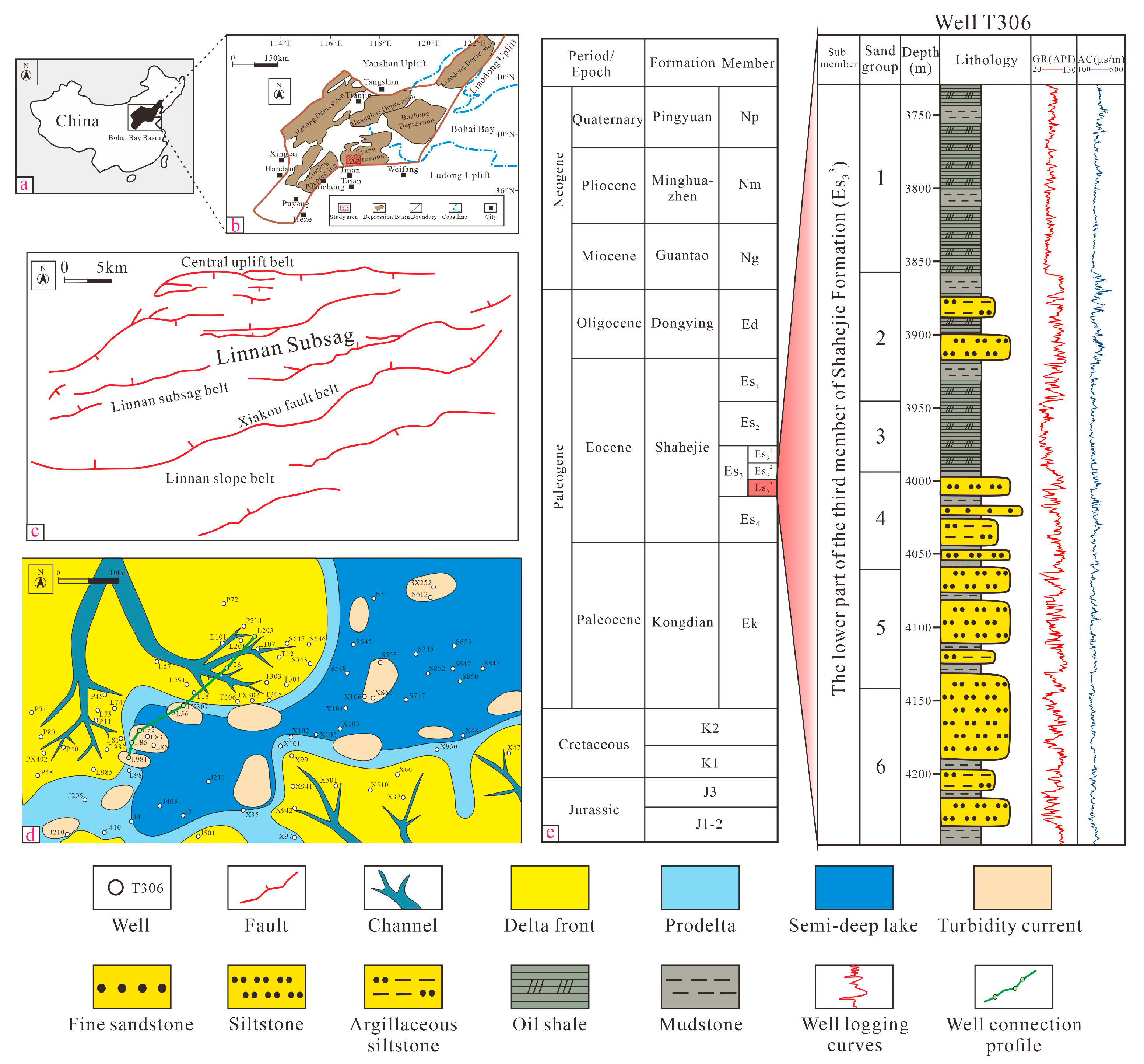
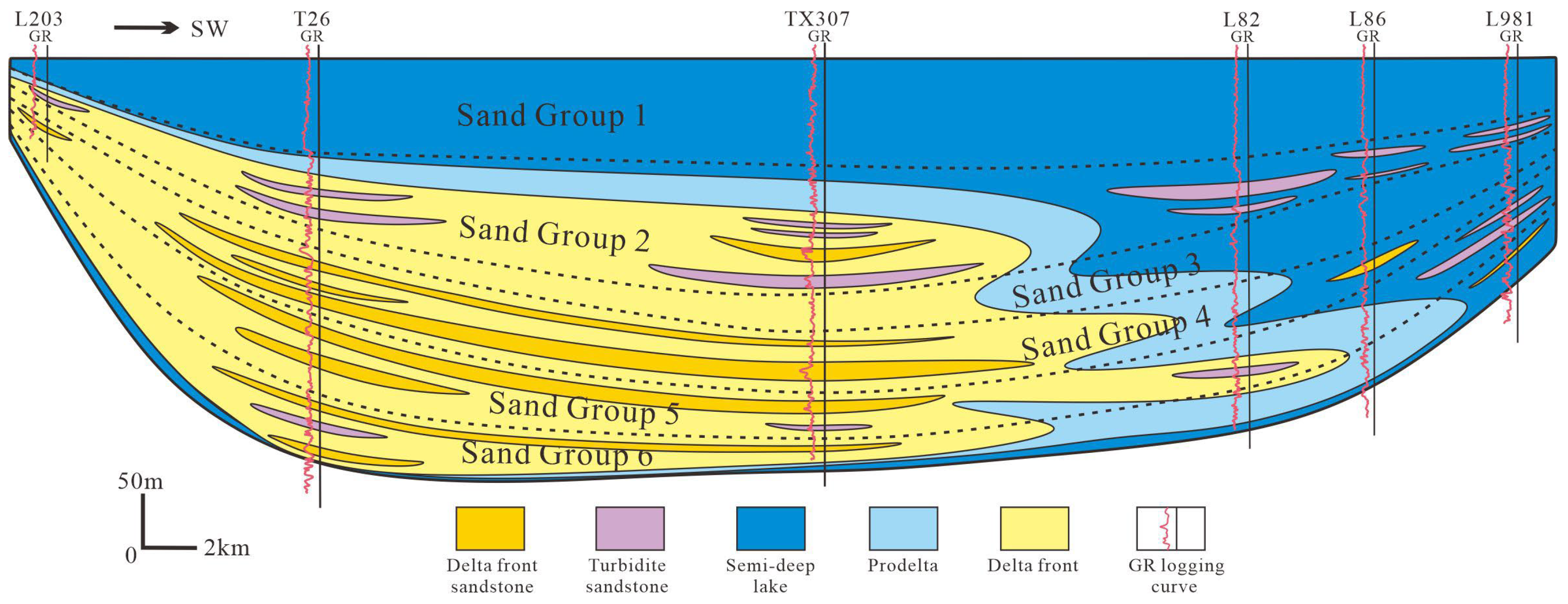
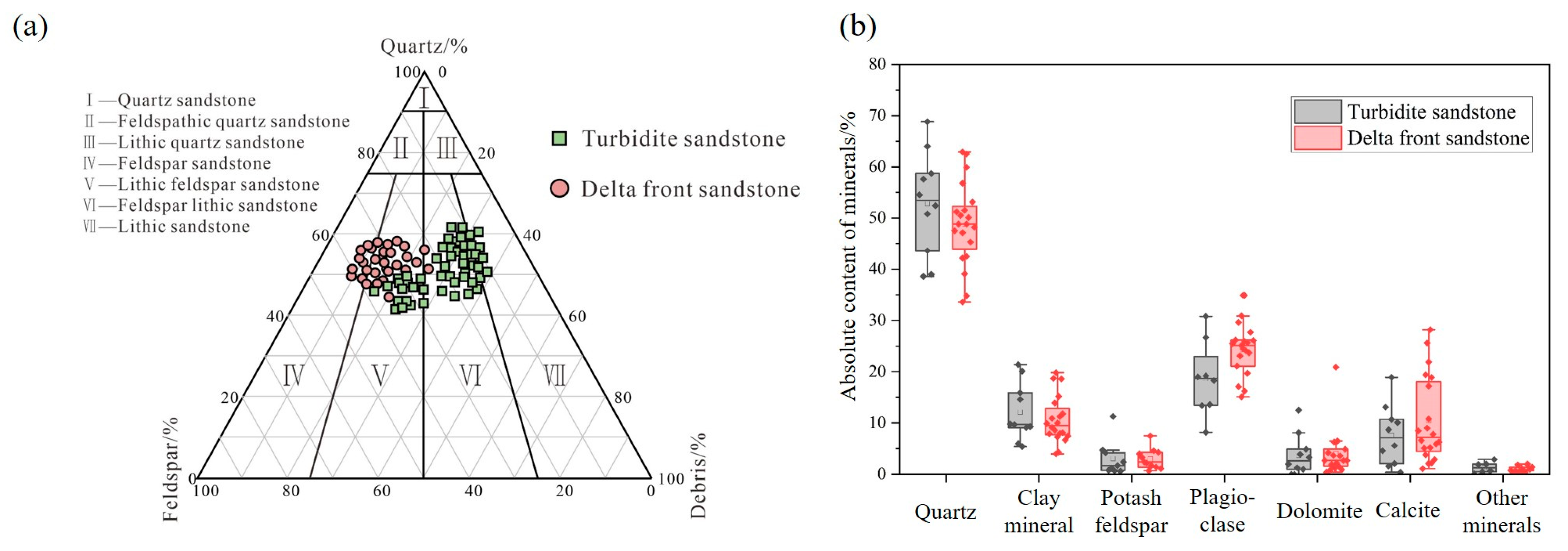

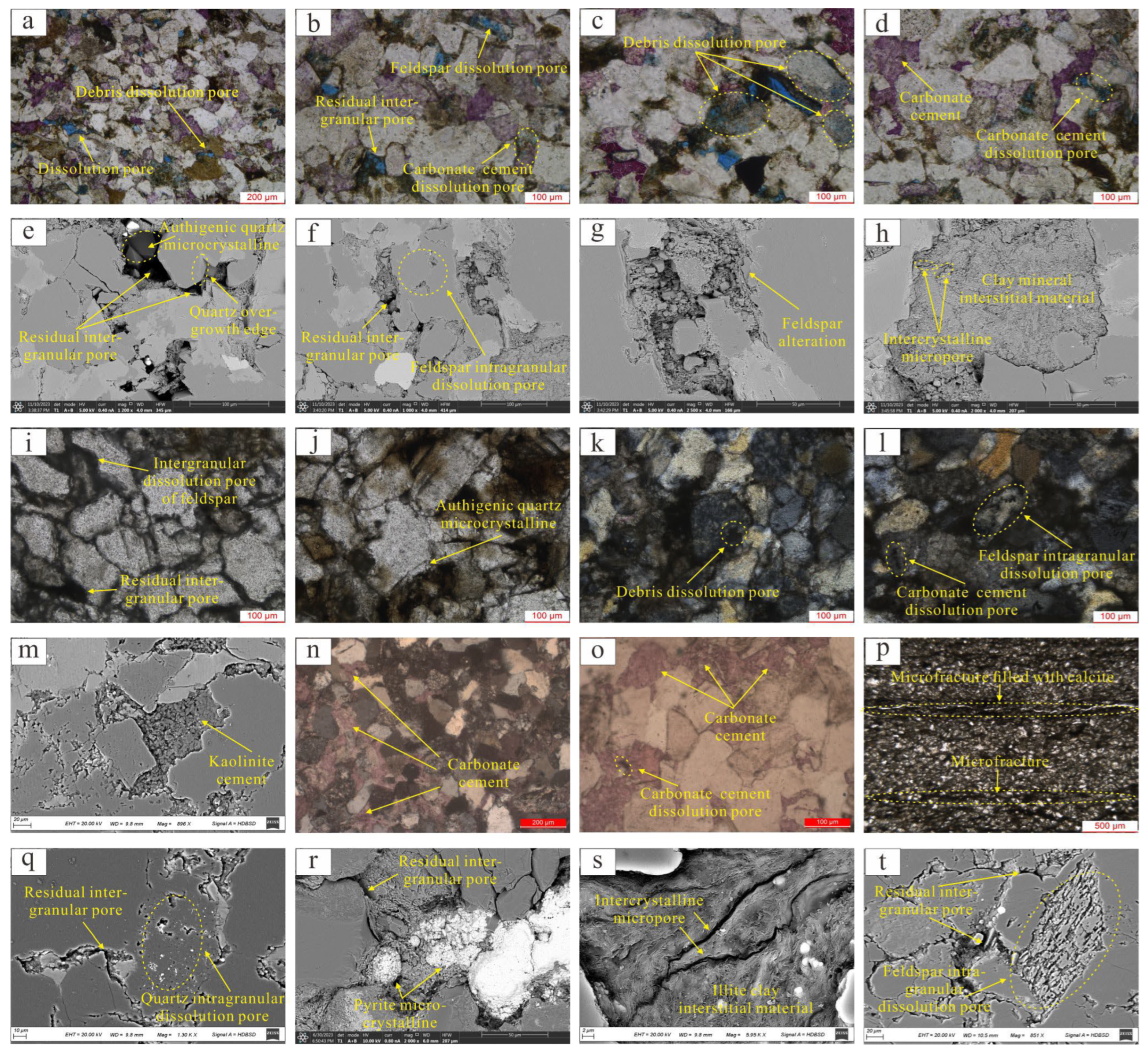
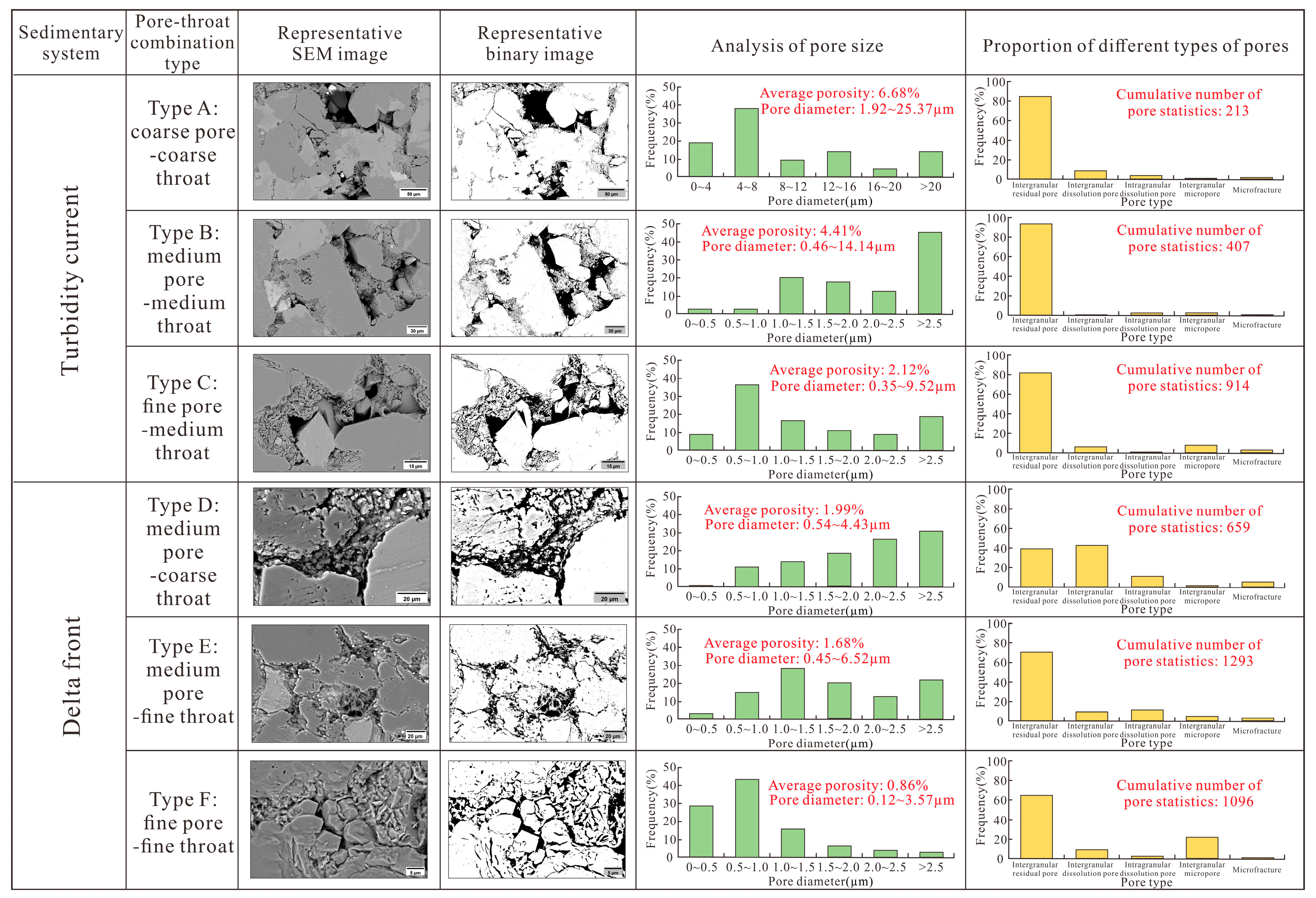
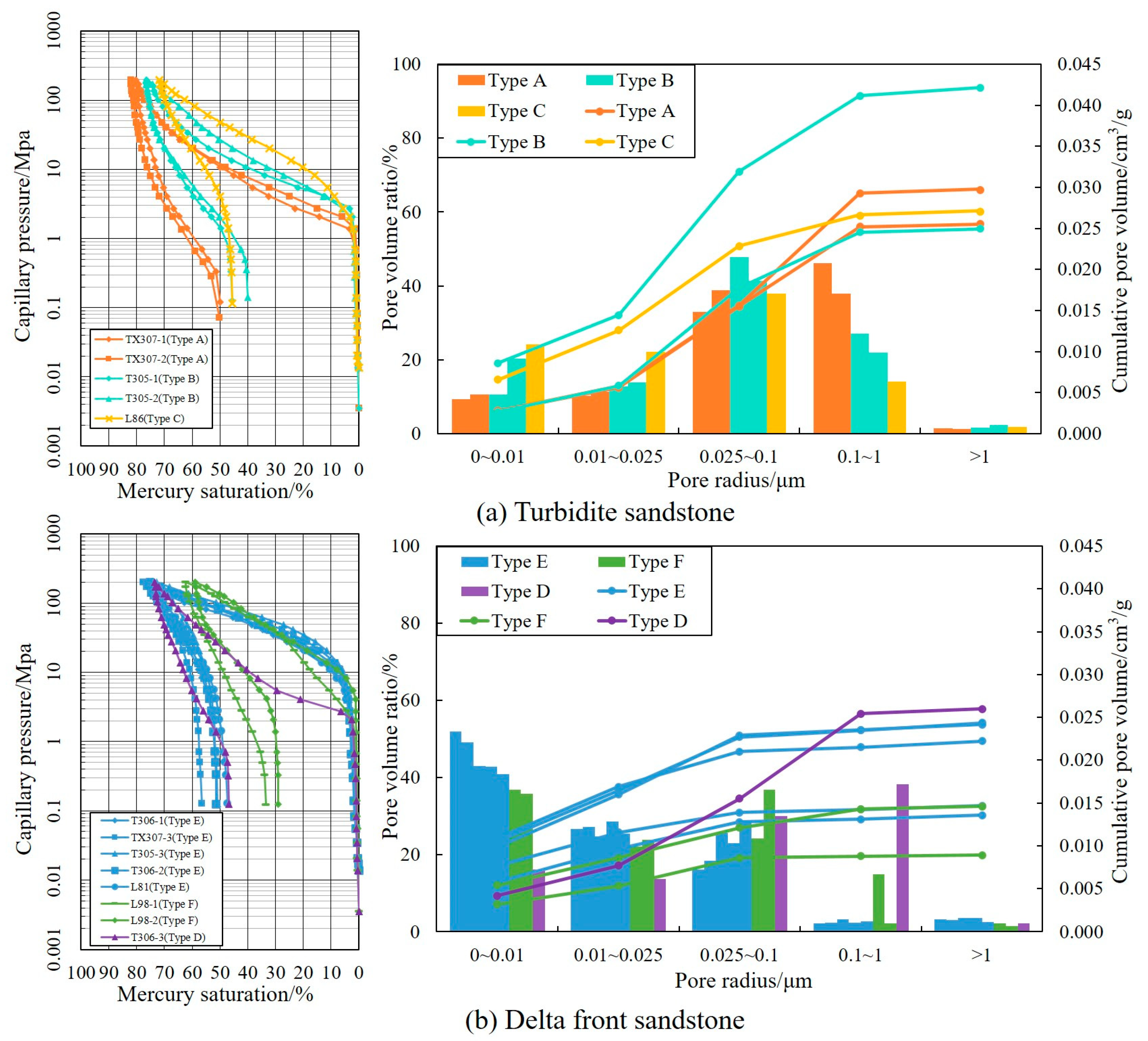

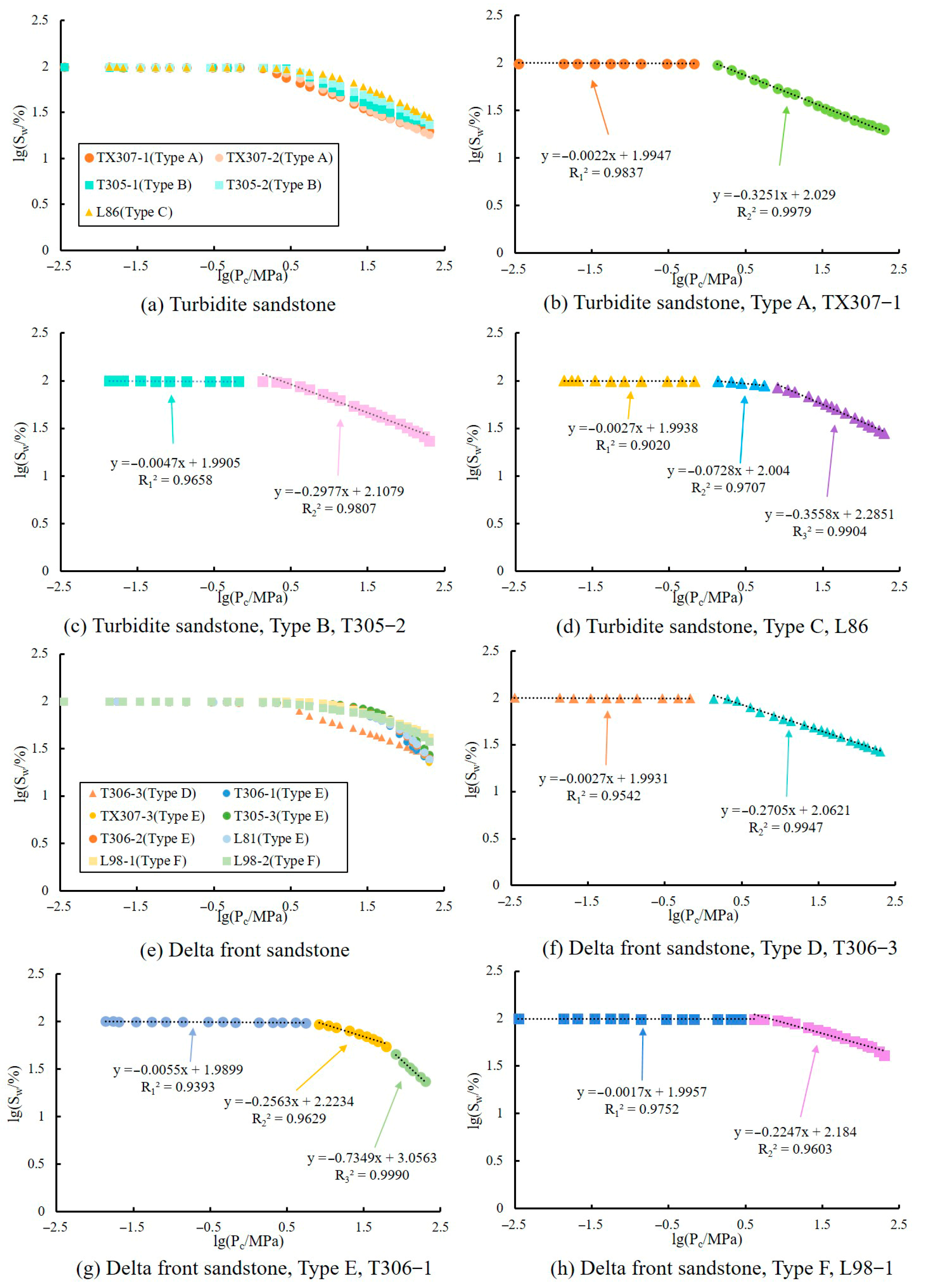
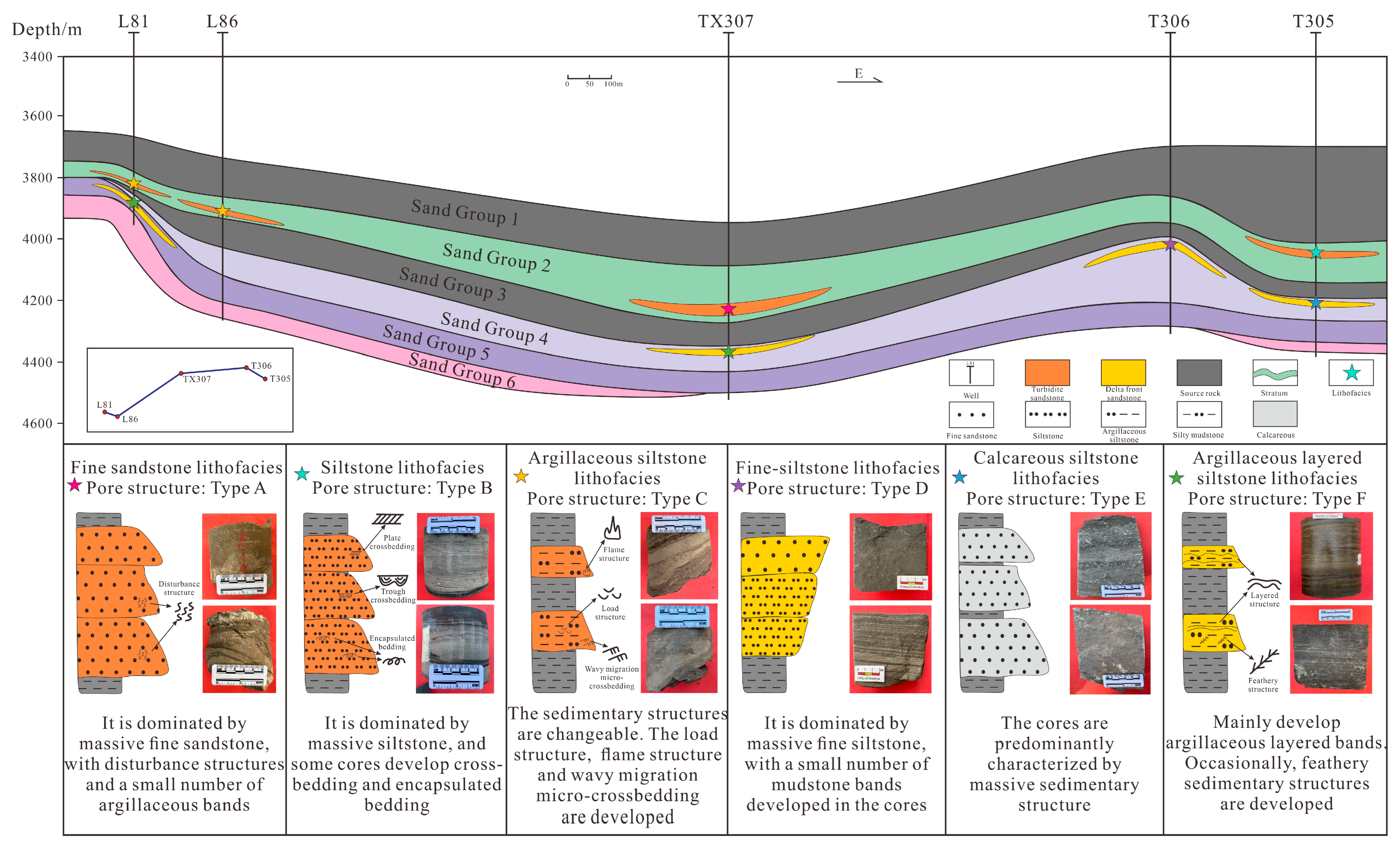



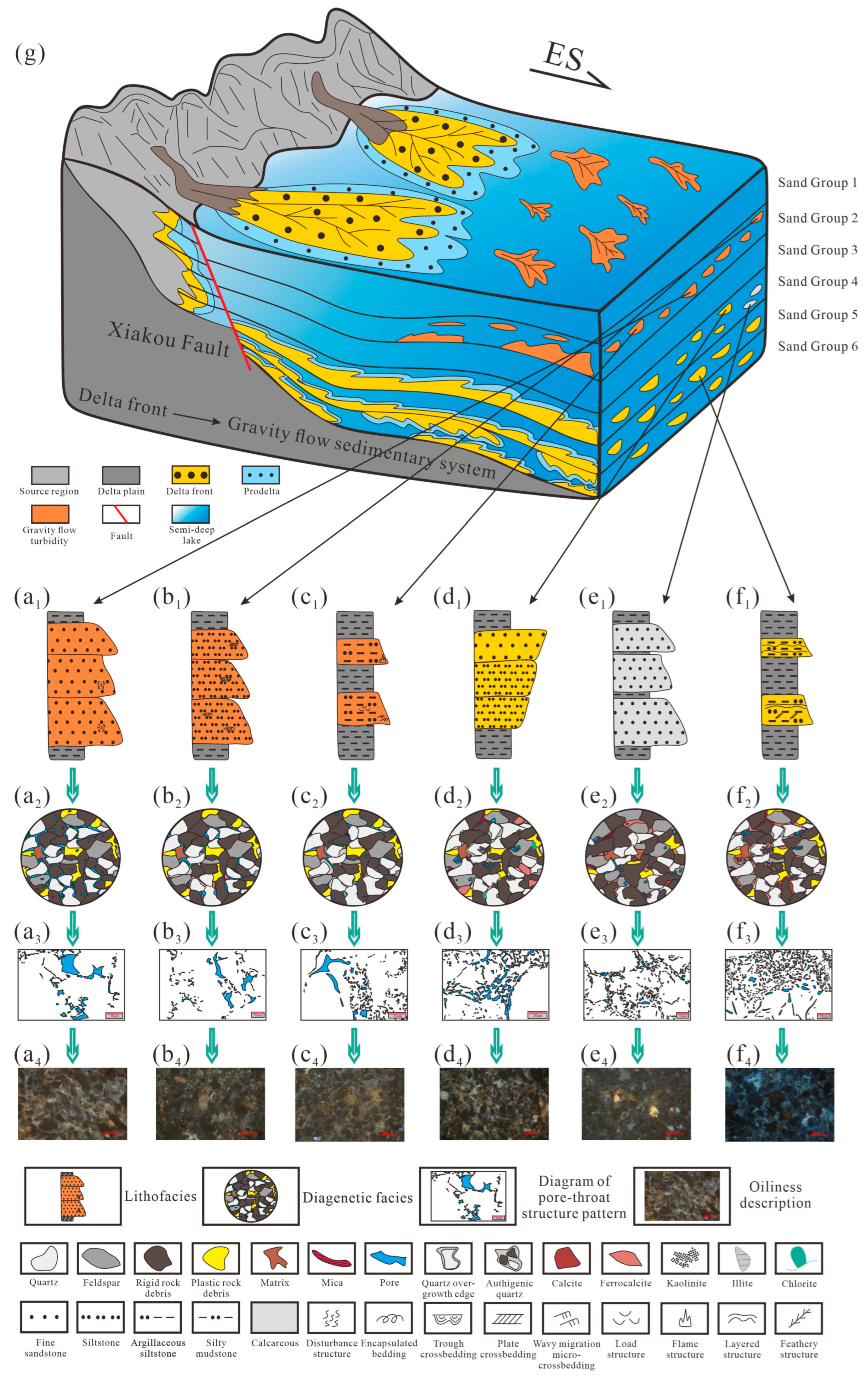
| Sedimentary System | Pore–Throat Combination Type | Sample Number | Porosity/% | Permeability/mD | D1 | D2 | D3 | |||
|---|---|---|---|---|---|---|---|---|---|---|
| D1 | R12 | D2 | R22 | D3 | R32 | |||||
| Turbidity current | Type A | TX307-1 | 12.565 | 0.837 | 2.998 | 0.9837 | 2.675 | 0.9979 | / | / |
| Type A | TX307-2 | 7.580 | 1.169 | 2.998 | 0.9749 | 2.643 | 0.9972 | / | / | |
| Type B | T305-1 | 8.870 | 0.391 | 2.998 | 0.9527 | 2.678 | 0.9879 | / | / | |
| Type B | T305-2 | 9.112 | 0.932 | 2.995 | 0.9658 | 2.702 | 0.9807 | / | / | |
| Type C | L86 | 7.841 | 0.306 | 2.997 | 0.9020 | 2.927 | 0.9707 | 2.644 | 0.9904 | |
| Delta front | Type D | T306-3 | 8.645 | 0.335 | 2.997 | 0.9542 | 2.730 | 0.9947 | / | / |
| Type E | T306-1 | 7.765 | 0.144 | 2.995 | 0.9393 | 2.744 | 0.9629 | 2.265 | 0.9990 | |
| Type E | TX307-3 | 7.153 | 0.025 | 2.992 | 0.9202 | 2.730 | 0.9482 | 2.078 | 0.9943 | |
| Type E | T305-3 | 5.175 | 0.034 | 2.994 | 0.9714 | 2.800 | 0.9228 | 2.183 | 0.9943 | |
| Type E | T306-2 | 4.620 | 0.054 | 2.993 | 0.9687 | 2.726 | 0.9547 | 2.221 | 0.9959 | |
| Type E | L81 | 7.865 | 0.106 | 2.993 | 0.9661 | 2.810 | 0.9459 | 2.283 | 0.9734 | |
| Type F | L98-1 | 3.889 | 0.188 | 2.998 | 0.9752 | 2.775 | 0.9603 | / | / | |
| Type F | L98-2 | 5.900 | 0.186 | 2.998 | 0.9653 | 2.808 | 0.9112 | / | / | |
Disclaimer/Publisher’s Note: The statements, opinions and data contained in all publications are solely those of the individual author(s) and contributor(s) and not of MDPI and/or the editor(s). MDPI and/or the editor(s) disclaim responsibility for any injury to people or property resulting from any ideas, methods, instructions or products referred to in the content. |
© 2025 by the authors. Licensee MDPI, Basel, Switzerland. This article is an open access article distributed under the terms and conditions of the Creative Commons Attribution (CC BY) license (https://creativecommons.org/licenses/by/4.0/).
Share and Cite
Rong, L.; Chen, D.; Wang, Y.; Chen, J.; Wang, F.; Wang, Q.; Lei, W.; Jiang, M. Pore Structure Differences and Influencing Factors of Tight Reservoirs Under Gravity Flow–Delta Sedimentary System in Linnan Subsag, Bohai Bay Basin. Appl. Sci. 2025, 15, 5800. https://doi.org/10.3390/app15115800
Rong L, Chen D, Wang Y, Chen J, Wang F, Wang Q, Lei W, Jiang M. Pore Structure Differences and Influencing Factors of Tight Reservoirs Under Gravity Flow–Delta Sedimentary System in Linnan Subsag, Bohai Bay Basin. Applied Sciences. 2025; 15(11):5800. https://doi.org/10.3390/app15115800
Chicago/Turabian StyleRong, Lanxi, Dongxia Chen, Yuchao Wang, Jialing Chen, Fuwei Wang, Qiaochu Wang, Wenzhi Lei, and Mengya Jiang. 2025. "Pore Structure Differences and Influencing Factors of Tight Reservoirs Under Gravity Flow–Delta Sedimentary System in Linnan Subsag, Bohai Bay Basin" Applied Sciences 15, no. 11: 5800. https://doi.org/10.3390/app15115800
APA StyleRong, L., Chen, D., Wang, Y., Chen, J., Wang, F., Wang, Q., Lei, W., & Jiang, M. (2025). Pore Structure Differences and Influencing Factors of Tight Reservoirs Under Gravity Flow–Delta Sedimentary System in Linnan Subsag, Bohai Bay Basin. Applied Sciences, 15(11), 5800. https://doi.org/10.3390/app15115800






